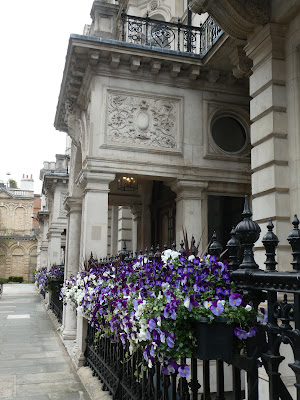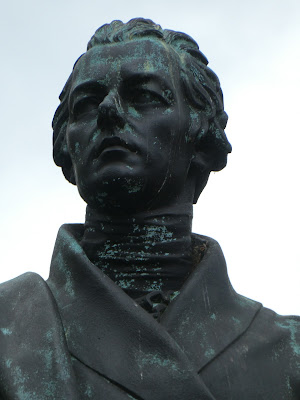Normally on a cold overcast day I would just stay at home. But we have had such a long period of alternating sun and showers (basically April showers in May) that I decided to go to do a walk just because the forecast was dry (albeit grey and windy). And Mayfair is quite convenient.
Your lesson for today. Mayfair is so named because a fair was held here each May. Obvious really.
So the starting point is Piccadilly Circus and so Eros. First shot tells you how grey a day it was.
This is, of course, one of London's best known statues. Designed by the renowned Alfred Gilbert and erected in 1893 it is the memorial to the seventh earl of Shaftesbury, one of the great Victorian philanthropists. It has, as a claim to fame,the fact that it is the world's first aluminium statue.
The model is apparently Gilbert's young assistant Angelo Colarossi. If so he was certainly a very handsome young man, and truly immortalised, although you need a good zoom lens to appreciate his physique!
The statue is well worth closer examination although normally you see it cloaked in young foreign tourists. But today it was cold, there is a pandemic and the spot had just been street cleaned, so I had it to myself. The detailing is is exquisite, in a very late Victorian, art nouveau manner.
So then I walked up the grand thoroughfare that is Piccadilly- St James Church.
Hatchards - a very splendid chocolate shop.
With Fortnum & Mason next door.
But nothing can match Burlington House. I normally just visit here as the home of the Royal Academy for exhibitions. But actually the whole courtyard is full of entrances to the various Royal Societies, Geological, Astronomical, Chemistry etc. The RA was founded in 1768 so a venerable institution, but Burlington House is much older, and a throwback to an earlier age. This dates not so much back to the Age of Enlightenment, but to the age when Mayfair was dotted with the grand mansions of the aristocracy. Burlington House is the last of these left, bought by the 1st Earl of Burlington in 1667. It is impossibly grand - hard to imagine as a private house with its massive courtyard.
This is the entrance to the courtyard looking back.
This nicely proportioned slim building on Albemarle Street dates back to 1719. It was home to the publishers of, among others, Jane Austen, Charles Dickens and Arthur Conan Doyle.
The least attractive building on the road might be the most lionised though. This dull and dated block was designed by Erno Goldfinger, considered one of the most influential architects of the mid 20th century
Much more exuberant and pleasing is the Royal Arcade - top class shopping only.
Browns Hotel has the distinction of being the oldest hotel in London, opening in 1837. Its other main claim to fame is being the place from which Alexander Graham Bell made the first phone call.
The Royal Institution, probably best known for its Christmas children's lectures.
This house on Dover Street was originally built in the 1770s for the Bishop of Ely - hence the bishop's mitre in the centre.
The impressive Third Church of Christ Scientist
Shepherd Market, nothing to do with sheep, but named after Edward Shepherd who laid out the street plan in 1735. It is now largely a combination of restaurants and art dealerships.
Always impressive to see a house with not one but two blue plaques..
Sheridan is rather more distinguished than Burgoyne, whose failings assisted American independence in the American Revolutionary War.
A more light hearted blue plaque.
You may think this looks like an Underground station and you would be right. This is, or rather was, Down Street on the Piccadilly Line until 1932, although it also saw sterling service as a bomb shelter in the War.
By far the most hideous building in what is a largely Georgian area in architectural terms is the Hilton Hotel. Could hardly be less sympathetic to the neighbourhood if they had put up a nuclear reactor.
Sir George Cayley - pioneer of aviation before the Wright Brothers - he built gliders in the mid 19th century - first tested out with a 10 year old boy as the "pilot", I guess on weight grounds.
Now it is a common and unsurprising misconception that the Georgians only built flat square houses. They actually used bay windows a lot, as shown here. But almost always at the rear of the house.
Here is the conventional Georgian front to the building above.
Above house was once home to Rufus Isaacs, 1st Marquess of Reading. He was the first Jew to be made Lord Chief Justice, and the first to raised to a marquessate. He also served as Viceroy of India and was the last Liberal to be Foreign Secretary.
This is a nice cul-de-sac called Chesterfield Gardens, with some very elaborate homes.
Terminating in this rather odd wall
Interesting pairing of blue plaques...
This is Hays Mews, once the "working end" of Berkeley Square, ie where you stabled the horses for the big houses.
And so to Berkeley Square itself, which despite the song is not great for nightingales. It is also a very large square, and swamped with traffic, so far from the most attractive of London squares. It would have been far nicer when new. It was developed in the 1740s in a bend of the River Tyburn (which has since entirely disappeared under the streetscape) on land owned by Lord Berkeley (hence the name). It is far from a harmonious sight now having been subject to much redevelopment on three sides, although the west side, which was the most select apparently, is the one that has largely survived.
Actually rather than say anything more about its history - here is the storyboard.
The garden in the centre contains huge plane trees which are apparently the oldest in London, but otherwise it is large but not as beautiful as many others.
The little pavilion in the centre was once a lead equestrian statue, but conditions weakened the metal over time and eventually the horse's legs simply buckled under the weight of the lead! Its replacement is pleasing enough and offers sheltered seating. Very civilized.
Quite a few notable folk lived around here, including Clive of India - a name to conjour with.
This I believe is the entrance to the posh nightclub Anabelles
While many London squares were laid out with perfect identical terraces around the central garden, some were not and this forms that category of irregular, one off houses. That doesn't make them displeasing, as below shot I think shows. They remain of similar size and all of course conform to some sense of classical design, but they are not all of equal height, material or detailing.
Below is 44 Berkeley Square which is supposed to be the finest Georgian house in London, designed by the great William Kent. I think, unfortunately, that is especially said because of the interior which is obviously not what is on show to the passer by, plus the fact that unusually compared to most other fine Georgian houses, it survived any Victorian improvements or gutting by modern developers. Photos of the interior look amazing - spectacular and palatial - while the exterior is nice but restrained. So what features makes the facade so good in the eyes of experts?
Well try this. "The brown brick, with its superb tuck pointing, dominates the facade but much excellent stone decoration is used - window architraves and pediments, a wide first floor cill band with blind balustrades, rusticated ground floor quoins and a lavish arched rusticated surround to the recessed doorway. The latter is enclosed by a stone consoled door surround surmounted by a segmental brick headed fanlight. The fine proportioning of the facade is pure Palladian with pronounced piano nobile, square windows above and topped with a cyma bracketed cornice."
Not quite my own words - from my book on London's Georgian Houses.
Off one corner of the square is Bruton Street. Only remarkable because the Queen was born there.
But the house is long gone and this is the replacement building. Let us say undistinguished.
This statue was apparently a gift from the Italian Government. Not sure what I would think of it if I unwrapped this on Christmas morning...
This lego like construction marks the entrance to Mount Street Gardens, another little oasis you won't have heard of.
On one side of the gardens is the Church of the Immaculate Conception - neo-Gothic so not as old as it looks- completed in 1849.
The gardens are small but beautifully planted in a sheltered spot, hence the palm tree.
Coming out of the gardens you find on one side the Grosvenor Chapel built in 1730, so very fine Georgian classicism...
...and on the other, the very late Victorian public library.
Next stop Grosvenor Square. This is larger and bleaker than Berkeley Square, with even less of its original Georgian surroundings. One end is currently a building site, having formerly been the US Embassy.
The Grosvenor Estate was laid out in 1720 by Sir Richard Grosvenor. The area remains largely owned by the family, now headed by the Duke of Westminster who usually appears near the top of any UK rich list. His ancestor William Gros Veneur (hence now Grosvenor, which sounds a lot better than the French translation of the original - fat hunter!) arrived with William the Conqueror but the family really hit lucky in the 17th century when Sir Thomas Grosvenor married one Mary Davies, the heiress to 500 acres of then rural land on the outskirts of London. Those fields became the top real estate of Mayfair and Belgravia.
Anyway, as I say not one of the lovelier squares, but it displays much influence from the USA, not just the old embassy.
There is this monument to US fighter pilots.
Statue of President Roosevelt.
And at one end a much more recent addition - a memorial garden to the dead from 9/11.
This is a rather beautiful memorial garden that should become even prettier with maturity.
And this Georgian house in the corner was home to the first US Ambassador to England, John Adams, in the 1780s.
From the US to the Ukraine. This is the Ukranian Catholic Cathedral, designed by Alfred Waterhouse, better known as the architect of the Natural History Museum.
On the opposite side of the street are another set of modest and very little known gardens, the Brown Hart Gardens. They are not "standard" gardens, but a paved set of gardens atop an electricity substation, with, for no apparent reason, brightly coloured monkeys perched on all four corners
Down on Brook Street one comes across a pair of Georgian houses with shops below and an unlikely pair of blue plaques on a musical theme, one for the German composer George Handel, beloved court composer of King George I, the other for American rock guitarist Jimi Hendrix who briefly lived here over 200 years later.
The last square on my walk was Hanover Square - quite impossible to properly appreciate because of the traffic and the fact that extensive building works are currently being carried out. As you can see, it is mostly covered by barriers.
But one thing to survive from the Georgian square is St George's Church, built by John James who was an apprentice of Sir Christopher Wren.
I then walked down Saville Row - tailors shops are really not very exciting, although a couple of notable ones at the end.
But when you get to the end you see the back of Burlington House.
And finally back to Piccadilly Circus along Regents Street, the finest of all London's planning schemes designed by John Nash.
















































































































































No comments:
Post a Comment